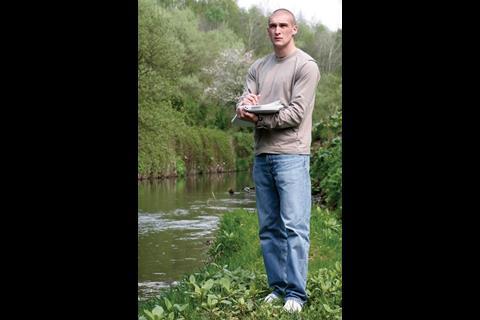If you want to know what you’re missing by not training, say hello to three young people who prove that investing in people has benefits not just to them but to the wider society.
Be generous, pleads Bura’s Sean Fleetwood. Think beyond the benefits a young employee brings to your company and try, instead, to see the long-term contribution they can make to the sector as a whole. That way, you won’t resent paying for their training and won’t be disappointed if, in years to come, they get itchy feet. Most important, you’ll be helping to address regeneration’s most vexing issue – its skills shortage.
The other piece of advice from the association’s business development manager is this: don’t get too hung up on formal qualifications at the recruitment stage. Certificates are easier to acquire than the right mindset. If someone has the right attitude, snap them up and train them in-house. This has worked for the following companies and their, as yet, loyal new recruits.
Inpartnership is a small company with big projects. Its modest staff of 15 has more than £2bn of large, complex regeneration projects in the North-west and the Midlands on its books. Its North Solihull redevelopment alone covers 1,000-plus acres. The developer is also unusual in that it works only in partnership with the public sector: other developers are then brought in to work for the partnership. Finding staff with the right combination of private and public sector skills is, says managing director Duncan Sutherland, “a real problem. With junior staff we do a lot of our training internally”.
Chloe McCarthy, 25, got her lucky break thanks to a contact. A Manchester transport company where she once temped recommended her to Sutherland. “I read English at university, but I didn ’t want to go into journalism, publishing or any other of the professions that traditionally follow an English degree.
“I also knew I didn’t want to return to London where I grew up and start paying London rents. So I stayed in Manchester where I had studied and started temping for a transport firm which passed on my name to Inpartnership. The company did me a very good turn. I began working as Duncan’s PA, and after a year was promoted to regeneration and community benefits manager – a rather unsnappy title for a job I love. I am definitely here for the long haul.
I find the construction aspects of the job geekily interesting
Chloe McCarthy
“I am interested in social enterprise and sustainability issues and particularly enjoy the community engagement aspect of my work. I also find the construction aspects of the job geekily interesting which is good because I think you need at least a basic comprehension of the technical aspects of regeneration to understand how projects are delivered. It’s the same with the commercial side of building – I am dealing with people who are property experts, so I need to know what they are talking about.
“I think my slightly unusual background is actually an advantage when it comes to working with residents. I understand people when they say they can’t comprehend why projects take so long to get off the ground, or when they complain they don’t follow what other members of the team are talking about – not so long ago, I felt those things too.”
Regeneration contractor Inspace is the name behind 1,600 new homes in the South-east and Midlands, and the maintenance of a further 65,000 across the country every year. Its new-build schemes cover all types of social housing from key worker accommodation, care homes and mixed-tenure apartments to multi-phase estate regeneration projects. The company, formerly Willmot Dixon Housing, employs about 1,000 people and plans to recruit a further 220 over the next 12 months. Some 40% of these newcomers will be management trainees who the company hopes will fill its senior positions in years to come, a strategy which to date has worked well. Around 8% of its new regenerators are school leavers like 20-year-old community liaison officer Jahana Begum.
“I have my aunty, a resident liaison officer, to thank for this job. We are very alike – bubbly, chatty people who like being out and about. So when Inspace advertised the same post and my aunt suggested I apply for it, I didn’t think twice.
“It was a temporary position, but after 18 months the company offered me the permanent post of community liaison officer. The work is very varied – I spend my days giving presentations at schools and colleges, producing newsletters, recording local employment data and, of course, on site where I work closely with the site managers. That is probably the hardest part of the job, particularly when we start a new site which is when people can be slightly hostile.
Working on site is the hardest part of the job – people can be slightly hostile
Jahana Begum
That said, I think I am naturally sympathetic to people’s fears about the dust and noise that building work entails. Plus, I have had good training to deal with challenging behaviour. I found a construction ambassador course, run by the CITB, and another on communication particularly useful. I now know, for example, that if people are really listening to you they tend to have open palms and big, open body gestures, and that if they blink a lot they might be trying to block something out. These are life skills. They aren’t just things that help me do my job.
“Another great thing about my work is the support I have had from my line manager. I’m about to start a degree in individual and community empowerment which Inspace is funding. I’ll graduate in five years’ time when I hope to be promoted to a managerial role. I’ll want some real recognition by then.”
New East Manchester is the area’s urban regeneration company and works with the public and private sectors to deliver long-term change to what is one of the most deprived parts of the country: 40% of east Manchester residents are unemployed, and more than 90% of locals live in 10% of England’s most deprived neighbourhoods, with 50% of them in the worst 1%. Since its inception in 2000, New East Manchester has seen employing local people as crucial to a 30-year regeneration programme that includes building 24,000 homes by 2025. To this end, the company has recruited eight east Mancunians as regeneration apprentices to its core team, with the intention of equipping them with the skills and, where appropriate, formal qualifications to forge a career in the sector.
Ryan Tracey, 24, is one of them.
“After I left six form college I drifted into a series of admin jobs which weren’t right for me. I had always wanted to work in the community, but didn’t know how to go about it. That changed last April when NEM posted a leaflet through my door saying it was looking to employ four locals as regeneration apprentices. The job title was new for me, but I had certainly noticed the changes the company had already made to the area: the new businesses and open spaces, the spruced-up streets. Together with 145 others, I applied for the job.
The number of courses I’ve been on runs into double figures
Ryan Tracey
“It was a great move. I like to think of myself as a people person and there’s plenty of scope for human interaction in this job. Lots of my time is spent meetings residents, local landlords, developers and community groups, and being local, from Clayton, means I relate to them well.
“Professionally, this job has certainly been good news, too. Presentation skills, report writing, minute taking, project management, confidence building – the number of courses I’ve been on runs into double figures, and the company is also paying for my degree in neighbourhood renewal.
“Another good thing about working for this organisation is that you can get promoted while still training. I’ve just had an interview for the post of project officer for an environmental projects team. I don’t know if I’ll get the job, but I do know I’ll definitely stay in regeneration, preferably locally. My dad won’t forgive me if I don’t! He’s very happy I’ve stayed in the area.”
Source
RegenerateLive




















No comments yet